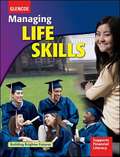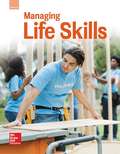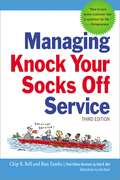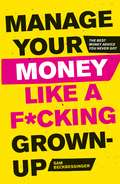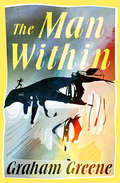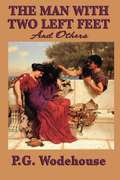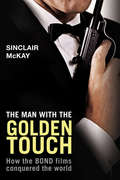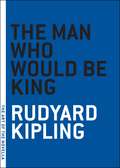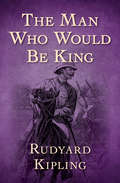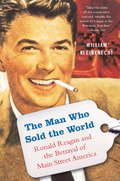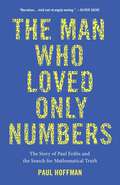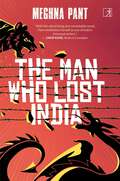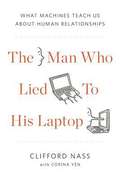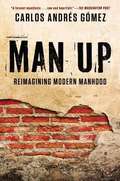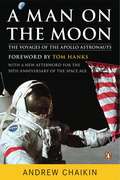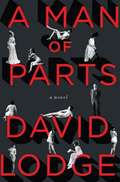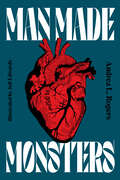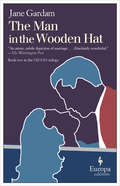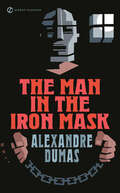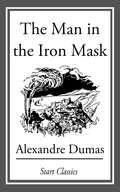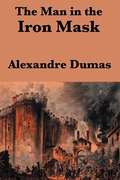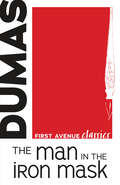- Table View
- List View
Managing Life Skills
by Patricia Clark Sue Couch Ginny FelstehausenBuild students' independent living skills and prepare them for success beyond high school withGlencoeManaging Life Skills. Students are prepared for career or college with full-page Career Pathway or College Readiness features. Career readiness focuses on thorough resume writing, job interview prep, and portfolio building activities and guidance. College Readiness includes information on scholarships, financial matters, and the college application process. Project-based pedagogy is used throughout the program through Unit Portfolio Projects, and financial education is thoroughly integrated.
Managing Life Skills
by McGraw-Hill EducationManaging Life Skills builds students’ independent living skills and prepares them for success beyond high school. Throughout the course, students will prepare for independent living, develop interpersonal and management skills, recognize healthy food choices.
Managing Life Skills
by McGraw-Hill-Glencoe Staff McGraw-Hill Education StaffBuild students' independent living skills and prepare them for success beyond high school! This program meets the newest FACS standards. Students are prepared for career or college with full-page Career Pathway or College Readiness features. Career cluster guidance, job outlook, education and training, and 21st Century Skills are included. * Career Readiness: is also focused on thorough résumé writing, job interview prep, and portfolio building activities and guidance. * College Readiness includes information on scholarships, financial matters, and the college application process. * Project-based pedagogy is used throughout this program through Unit Portfolio Projects. * Financial literacy education is integrated throughout this program, both in the context of projects and activities and with specific chapter-based Financial Literacy features that include math practice. * 21st Century Skills: Time-management skills, leadership skills, interpersonal skills, and teamwork skills are focused on. * Succeed in School and Life features appear throughout each chapter to reinforce skills concepts and applications. * Rigorous, standards-based academic integration to support the Perkins legislation mandate is included. * Family and community connections are approached through activities in each chapter. * Independent living skills, self-discovery, and value-based self-affirmation are focused on. Includes: Print student edition
Managing Knock Your Socks Off Service (Knock Your Socks Off Ser.)
by Ron Zemke Chip R. Bell John BushIn our increasingly connected world, customer service can make or break a business. Companies that excel keep customers coming back--and those who don't soon discover that word spreads fast. The difference is in how managers train, coach, and support frontline employees. Extensively revised with today's empowered, web-savvy consumer in mind, Managing Knock Your Socks Off Service shows managers and supervisors how to: * Find and retain service-oriented people * Understand customer needs, expectations and desires * Build a service vision * Design a user-friendly service delivery process * Involve and inspire employees * Recognize and reward good performance. The third edition features new chapters on: learning from lost customers; inciting passion and incentivizing service; fostering trust; and delivering great customer experiences online. In short, everything readers need to ensure their frontline employees become their company's biggest asset.
Manage Your Money Like a F*cking Grown-Up: The Best Money Advice You Never Got
by Sam BeckbessingerYou're going to earn plenty of money over your lifetime. Are you going to waste it on stupid crap that doesn't make you happy, or let it buy your freedom and your most audacious dreams?We never get an instruction manual about how money works. Most of what we learn about money comes from advertising or from other people who know as little as we do. No wonder we make such basic mistakes. No wonder we feel disempowered and scared. No wonder so many of us just decide to stick our heads in the damn sand and never deal with it. In Manage Your Money Like a F*cking Grown Up, Sam Beckbessinger tells it to you straight: how to take control of your money to take control of your life.In this clear and engaging basic guide to managing your finances, you will learn: - How to trick your dumb brain into saving more, without giving up fun- How to make a bona fide grown-up budget- Why you need to forget what you've learned about credit- How to negotiate a raise- Why buying a house (probably) won't make you rich- The one super-simple investment you needWith helpful exercises, informative illustrations (also: kittens) and straightforward advice, this book doesn't shy away from the psychology of money, and is empowering, humorous and helpful. The book you wish you'd had at 25, but is never too late to read.
The Man Without a Face
by Isabelle HollandCharles didn't know much about life ... until he met The Man Without a Face. "I'd never had a friend, and he was my friend; I'd never really, except for a shadowy memory, had a father, and he was my father. I'd never known an adult I could communicate with or trust, and I communicated with him all the time, whether I was actually talking to him or not. And I trusted him ...... Fourteen-year-old Charles desperately wants two things: a father and a way out. Little love has come his way until the summer he befriends a mysterious scarred man named Justin McLeod, nicknamed ""The Man Without a Face." Charles enlists McLeod's help as tutor for the St. Matthew's school entrance exams, his ticket away from the unpleasant restrictions of his home life. But more important than anything he could get out of a book, that summer Charles learns from McLeod a stirring life lesson about the many faces of love.
The Man Within (Virago Modern Classics)
by Graham GreeneThe “strikingly original” debut novel by the masterful British author is “a perfect adventure” of love and smuggling on the English coast (The Nation). Francis Andrews is a reluctant smuggler living in the shadow of his brutish father’s legacy. To exorcise the ghosts of the man he loathes, Andrews betrays his colleagues to authorities and takes flight across the downs. It’s here that he stumbles upon the isolated cottage of a beguiling stranger named Elizabeth—an empathetic young woman who is just as lonely, every bit the outsider as he, and reconciling a troubling past of her own. Andrews, a man on the run from those he exposed, believes he’s found refuge and salvation. But when Elizabeth encourages him to return to the courts of Lewes and give evidence against his accomplices, the treacherous and deadly repercussions may be beyond their control. “The ultimate strengths of [Graham] Greene’s books is that he shows us the hazards of compassion,” a theme that would find its earliest expression in The Man Within, his first published novel (Pico Iyer).
The Man With Two Left Feet
by P. G. WodehouseThe Man With Two Left Feet, and Other Stories is a collection of short stories by P. G. Wodehouse, first published in the United Kingdom in 1917 by Methuen & Co., London. Many of the stories had previously appeared in the Strand in the UK and the Saturday Evening Post in the U.S. Most of the stories concern relationships, sports, and household pets. None feature any of Wodehouse's regular characters. "Extricating Young Gussie" marks the first appearance of some of Wodehouse's most well-known and beloved characters, Jeeves and his master Bertie Wooster (although here Bertie's surname appears to be Mannering-Phipps, and Jeeves' role is very small), along with Bertie's fearsome Aunt Agatha.
The Man with the Golden Touch: How The Bond Films Conquered the World
by Sinclair MckayWhen Albert R. Broccoli and Harry Saltzman set out to make what they expected to be the first of three or four movies based on the espionage novels of Ian Fleming they can hardly have dreamt that they were founding a business that would still be going str Yet the role of James Bond, which transformed Sean Connery’s career in 1962 when Dr No came out, still retained its star-making power in 2006 when Daniel Craig made his Bond debut in Casino Royale. This is the story of how, with the odd misstep along the way, the owners of the Bond franchise, Eon Productions, have contrived to keep James Bond abreast of the zeitgeist and at the top of the charts for 45 years, through 21 films featuring six Bonds, three M’s, two Q’s and three Moneypennies. Thanks to the films, Fleming’s original creation has been transformed from a black sheep of the post-war English upper classes into a figure with universal appeal, constantly evolving to keep pace with changing social and political circumstances. Having interviewed people concerned with all aspects of the films, Sinclair McKay is ideally placed to describe how the Bond ‘brand’ has been managed over the years as well as to give us the inside stories of the supporting cast of Bond girls, Bond villains, Bond cars and Bond gadgetry. Sinclair McKay, formerly assistant features editor of the Daily Telegraph, works as a freelance writer and journalist. He is also the author of A Thing of Unspeakable Horror: The History of Hammer Films, which the Guardian called ‘A splendid history’ and the Independent on Sunday described as ‘Brisk, cheerful and enthusiastic.’
The Man with the Golden Touch: How The Bond Films Conquered the World
by Sinclair MckayWhen Albert R. Broccoli and Harry Saltzman set out to make what they expected to be the first of three or four movies based on the espionage novels of Ian Fleming they can hardly have dreamt that they were founding a business that would still be going str Yet the role of James Bond, which transformed Sean Connery's career in 1962 when Dr No came out, still retained its star-making power in 2006 when Daniel Craig made his Bond debut in Casino Royale. This is the story of how, with the odd misstep along the way, the owners of the Bond franchise, Eon Productions, have contrived to keep James Bond abreast of the zeitgeist and at the top of the charts for 45 years, through 21 films featuring six Bonds, three M's, two Q's and three Moneypennies. Thanks to the films, Fleming's original creation has been transformed from a black sheep of the post-war English upper classes into a figure with universal appeal, constantly evolving to keep pace with changing social and political circumstances. Having interviewed people concerned with all aspects of the films, Sinclair McKay is ideally placed to describe how the Bond 'brand' has been managed over the years as well as to give us the inside stories of the supporting cast of Bond girls, Bond villains, Bond cars and Bond gadgetry. Sinclair McKay, formerly assistant features editor of the Daily Telegraph, works as a freelance writer and journalist. He is also the author of A Thing of Unspeakable Horror: The History of Hammer Films, which the Guardian called 'A splendid history' and the Independent on Sunday described as 'Brisk, cheerful and enthusiastic.'
The Man Who Would Be King: Large Print (The Art of the Novella)
by Rudyard Kipling"My gord, Carnehan," says Daniel, "This is a tremenjus business, and we've got the whole country as far as it's worth having."Literature's most famous adventure story, this stirring tale of two happy-go-lucky British ne're-do-wells trying to carve out their own kingdom in the remote mountains of Afghanistan has also proved over time to be a work of penetrating and lasting political insight--amidst its raucous humor and swashbuckling bravado is a devastatingly astute dissection of imperialism and its heroic pretensions. Written when he was only 22 years old, the tale also features some of Rudyard Kipling's most crystalline prose, and one of the most beautifully rendered, spectacularly exotic settings he ever used. Best of all, it features two of his most unforgettable characters, the ultra-vivid Cockneys Peachy Carnahan and Daniel Dravot, who impart to the story its ultimate, astonishing twist: it is both a tragedy and a triumph.The Art of The Novella Series Too short to be a novel, too long to be a short story, the novella is generally unrecognized by academics and publishers. Nonetheless, it is a form beloved and practiced by literature's greatest writers. In the Art Of The Novella series, Melville House celebrates this renegade art form and its practitioners with titles that are, in many instances, presented in book form for the first time.From the Trade Paperback edition.
The Man Who Would Be King: Large Print
by Rudyard KiplingSwashbuckling British adventurers find triumph and tragedy in nineteenth-century Afghanistan in this novella J. M. Barrie called "the most audacious thing in fiction." While on tour in India, a British journalist encounters Daniel Dravot and Peachey Carnehan, two foolhardy drifters with a plan. Claiming they've exhausted all the schemes and odd jobs they could find in India, the two are in search of an even greater adventure. They tell the journalist they're venturing to nearby Kafiristan--modern-day Afghanistan--to depose a weak ruler and establish themselves as kings. With a cache of the best rifles and knowledge of Masonic rituals that will baffle the native tribesmen, Daniel and Peachey don't see how they can fail. But they may have underestimated the locals . . . Inspired by tales of real-life explorers, Rudyard Kipling wrote The Man Who Would Be King when he was only twenty-two years old. Featuring vivid prose, exotic settings, and unforgettable characters, this dissection of the heroic pretensions of imperialism and colonialism is a swashbuckling tale for the ages, and served as inspiration for the 1975 John Huston film starring Sean Connery and Michael Caine.
The Man Who Sold the World: Ronald Reagan and the Betrayal of Main Street America
by William KleinknechtSince Ronald Reagan left office-and particularly after his death-his shadow has loomed large over American politics: Republicans and many Democrats have waxed nostalgic, extolling the Republican tradition he embodied, the optimism he espoused, and his abilities as a communicator. This carefully calibrated image is complete fiction, argues award-winning journalist William Kleinknecht. The Reagan presidency was epoch shattering, but not-as his propagandists would have it-because it invigorated private enterprise or made America feel strong again. His real legacy was the dismantling of an eight-decade period of reform in which working people were given an unprecedented sway over our politics, our economy, and our culture. Reagan halted this almost overnight. In the tradition of Thomas Frank’s What’s the Matter with Kansas?, Kleinknecht explores middle America-starting with Reagan’s hometown of Dixon, Illinois-and shows that as the Reagan legend grows, his true legacy continues to decimate middle America.
The Man Who Loved Only Numbers: The Story of Paul Erdos and the Search for Mathematical Truth
by Paul Hoffman"A funny, marvelously readable portrait of one of the most brilliant and eccentric men in history." --The Seattle Times Paul Erdos was an amazing and prolific mathematician whose life as a world-wandering numerical nomad was legendary. He published almost 1500 scholarly papers before his death in 1996, and he probably thought more about math problems than anyone in history. Like a traveling salesman offering his thoughts as wares, Erdos would show up on the doorstep of one mathematician or another and announce, "My brain is open." After working through a problem, he'd move on to the next place, the next solution. Hoffman's book, like Sylvia Nasar's biography of John Nash, A Beautiful Mind, reveals a genius's life that transcended the merely quirky. But Erdos's brand of madness was joyful, unlike Nash's despairing schizophrenia. Erdos never tried to dilute his obsessive passion for numbers with ordinary emotional interactions, thus avoiding hurting the people around him, as Nash did. Oliver Sacks writes of Erdos: "A mathematical genius of the first order, Paul Erdos was totally obsessed with his subject--he thought and wrote mathematics for nineteen hours a day until the day he died. He traveled constantly, living out of a plastic bag, and had no interest in food, sex, companionship, art--all that is usually indispensable to a human life."The Man Who Loved Only Numbers is easy to love, despite his strangeness. It's hard not to have affection for someone who referred to children as "epsilons," from the Greek letter used to represent small quantities in mathematics; a man whose epitaph for himself read, "Finally I am becoming stupider no more"; and whose only really necessary tool to do his work was a quiet and open mind. Hoffman, who followed and spoke with Erdos over the last 10 years of his life, introduces us to an undeniably odd, yet pure and joyful, man who loved numbers more than he loved God--whom he referred to as SF, for Supreme Fascist. He was often misunderstood, and he certainly annoyed people sometimes, but Paul Erdos is no doubt missed. --Therese Littleton
The Man Who Lost India
by Meghna PantThe year is 2032. China declares war on India. Pillage and plunder ensues. The war comes to an abrupt halt when a supernatural event saves the obscure town of Lalbag from annihilation. Even as China renews its efforts to invade Lalbag, a greater calamity awaits this sleepy town. A Chinese cop stumbles upon a dangerous secret that threatens to end the town&’s immunity. A fierce and forbidden love between a servant and his mistress destroys two families. Meanwhile, the town&’s richest man becomes afflicted with a terrible disease, the town beauty goes mad when her love betrays, and a psychic turns water into blood, sending the town and its people deeper into tragedy. A dystopian never-been-done-before tale set in – and between – China and India, The Man Who Lost India is a powerful portrayal of love, strife and family in the wake of 21st century&’s biggest war. Incantatory and atmospheric, this is Meghna Pant&’s most ambitious novel yet, full of beauty, bloodshed and undeniable feminist power.
The Man Who Lied to His Laptop: What We Can Learn About Ourselves from Our Machines
by Nass Clifford Yen CorinaLying to a laptop so we don't hurt its feelings; yelling at a GPS in frustration; feeling flattered by random praise from a computer-people act strangely around artificial intelligence. Stranger still that how we act around computers is so similar to how we act towards other people, and that we can learn a lot about human interaction from how we respond to computers. Pioneering researcher Clifford Nass has done numerous experiments centered around human/computer interaction that not only expose the similarities between how we act towards technology and how we act toward people, but illuminate the surprising nature of person-to-person interactions. Nass has been able to show that, from flattery to empathy to loyalty, many aspects of human behavior and emotion are identical whether we're dealing with computers or people. Based on his findings, Nass has developed rules for successful relationships in any area of life. For instance: Don't smile to soften criticism-match your delivery to your content for best results Crack jokes-innocent humor makes people happier with their work without harming their efficiency (and the joke doesn't even have to be funny!) Empathize-acting happy around a sad person (or vice versa) makes that person perform demonstrably worse at task The way we treat computers has deep ramifications for everything from praise and criticism to credibility to team-building. Nass is pushing into the next frontier of behavioral science.
Man Up: Reimagining Modern Manhood
by Carlos Andres GomezInspired by the award-winning poet and actor's acclaimed one-man play, a powerful coming-of-age memoir that reimagines masculinity for the twenty-first-century male. Award-winning poet, actor, and writer Carlos Andrés Gómez is a supremely gifted storyteller with a captivating voice whose power resonates equally on the live stage and on the page. In one of his most moving spoken-word poems, Gómez recounts a confrontation he once had after accidentally bumping into another man at a club. Just as they were about to fight, Gómez experienced an unexplainable surge of emotion that made his eyes well up with tears. Everyone at the scene jumped back, as if crying, or showing vulnerability, was the most insane thing that Gómez could possibly have done.Like many men in our society, Gómez grew up believing that he had to be ready to fight at all times, treat women as objects, and close off his emotional self. It wasn't until he discovered acting that he began to see the true cost of squelching one's emotions--and how aggression dominates everything that young males are taught.Statistics on graduation rates, employment, and teen and young-adult suicide make it clear that the young males in our society are at a crisis point, but Gómez seeks to reverse these ominous trends by sharing the lessons that he has learned. Like Hill Harper's Letters to a Young Brother, Man Up will be an agent for positive change, galvanizing men--but also mothers, girlfriends, wives, and sisters--to rethink and reimagine the way all men interact with women, deal with violence, handle fear, and express emotion.
A Man on the Moon: The Voyages Of The Apollo Astronauts
by Andrew Chaikin Tom HanksWhen astronauts Neil Armstrong and Buzz Aldrin took their 'giant leap for mankind' across a ghostly lunar landscape, they were watched by some 600 million people on Earth 240,000 miles away. <p><p> Drawing on hundreds of hours of in-depth interviews with the astronauts and mission personnel, this is the story of the twentieth century's greatest human achievement, minute-by-minute, through the eyes of those who were there. <p> From the tragedy of the fire in Apollo 1 during a simulated launch, Apollo 8's bold pioneering flight around the moon, through to the euphoria of the first moonwalk, and to the discoveries made by the first scientist on the moon aboard Apollo 17, this book covers it all.
A Man of Parts
by David LodgeThe mind is a time machine that travels backwards in memory and forwards in prophecy, but he has done with prophecy nowa' Sequestered in his blitz-battered house on the rim of Regent's Park, as the second war he has lived through moves into its final phase, the ailing Herbert George Wells, 'H. G. ' to his family and friends, looks back on a life crowded with incident, books, and women. Has it been a success or a failure?Once he was the most famous writer in the world, 'the man who invented tomorrow'; now he feels like yesterday's man, deserted or disparaged by readers, and depressed by the collapse of his utopian dreams for mankind. He recalls his unpromising start in life, and early struggles to acquire an education and make a living; his meteoric rise to fame as a writer with a prophetic imagination and a comic common touch, which brought him into contact with most of the important literary, intellectual, and political figures of his time; his plunge into socialist politics; his belief in free love, and energetic practice of it. Arguing with himself about his conduct, he relives his relationships with two wives and many mistresses, especially the brilliant student Amber Reeves and the gifted writer Rebecca West, both of whom bore him children, with dramatic and long-lasting consequences. Unfolding this astonishing life story, David Lodge achieves a riveting portrait of a man who embodied as many contradictions as he had talents: a socialist who enjoyed his affluence, a Darwinian evolutionist imbued with religious idealism, an acclaimed novelist who turned against the literary novel; a feminist womaniser, sensual yet incurably romantic, irresistible and exasperating by turns to those who knew him personally, but always vitally human.
Man Made Monsters
by Andrea RogersTsalagi should never have to live on human blood, but sometimes things just happen to sixteen-year-old girls. <p><p> Making her YA debut, Cherokee writer Andrea L. Rogers takes her place as one of the most striking voices of the horror renaissance that has swept the last decade. <p><p> Horror fans will get their thrills in this collection – from werewolves to vampires to zombies – all the time-worn horror baddies are there. But so are predators of a distinctly American variety – the horrors of empire, of intimate partner violence, of dispossession. And so too the monsters of Rogers’ imagination, that draw upon long-told Cherokee stories – of Deer Woman, fantastical sea creatures, and more. <p><p> Following one extended Cherokee family across the centuries, from the tribe’s homelands in Georgia in the 1830s to World War I, the Vietnam War, our own present, and well into the future, each story delivers a slice of a particular time period that will leave readers longing for more. <p><p> Alongside each story, Cherokee artist and language technologist Jeff Edwards delivers haunting illustrations that incorporate Cherokee syllabary. But don’t just take it from us – award-winning writer of The Only Good Indians and Mongrels Stephen Graham Jones says that "Andrea Rogers writes like the house is on fire and her words are the only thing that can put it out." <p><p> Man Made Monsters is a masterful, heartfelt, haunting collection ripe for crossover appeal – just don’t blame us if you start hearing things that go bump in the night.
The Man in the Wooden Hat (Old Filth Trilogy #2)
by Jane GardamThe New York Times called Sir Edward Feathers one of the most memorable characters in modern literature. A lyrical novel that recalls his fully lived life, Old Filth has been acclaimed as Jane Gardam?s masterpiece, a book where life and art merge. And now that beautiful, haunting novel has been joined by a companion that also bursts with humor and wisdom: The Man in the Wooden Hat. Old Filth was Eddie?s story. The Man in the Wooden Hat is the history of his marriage told from the perspective of his wife, Betty, a character as vivid and enchanting as Filth himself. They met in Hong Kong after the war. Betty had spent the duration in a Japanese internment camp. Filth was already a successful barrister, handsome, fast becoming rich, in need of a wife but unaccustomed to romance. A perfect English couple of the late 1940s. As a portrait of a marriage, with all the bittersweet secrets and surprising fulfillment of the 50-year union of two remarkable people, the novel is a triumph. The Man in the Wooden Hat is fiction of a very high order from a great novelist working at the pinnacle of her considerable power. It will be read and loved and recommended by all the many thousands of readers who found its predecessor, Old Filth, so compelling and so thoroughly satisfying. .
The Man in the Iron Mask
by Roger Celestin Alexandre Dumas Jack ZipesDeep inside the dreaded Bastille, a young prisoner has languished, his face hidden from all, for eight long years. He knows neither his true identity nor the crime that got him there. Then Aramis, one of the original three musketeers--the finest swordsmen in all of France--bribes his way into the young man's cell to reveal the shocking truth. The revelation of this truth could very well topple Louis XIV, King of France, from his throne--and Aramis aims to do just that. But a daring jailbreak, a brilliant masquerade, and a bloody fight for the throne may make Aramis betray his sacred vow of "All for one, one for all." And in so doing, he will pit musketeer against musketeer, bringing an end to this swashbuckling saga--and either honor or disgrace upon them all.... "The name Alexandre Dumas is more than French--it is universal."--Victor Hugo With a New Introduction by Roger Celestin and an Afterword by Jack Zipes
The Man in the Iron Mask
by Alexandre DumasDeep inside the dreaded Bastille, a young prisoner has languished, his face hidden from all, for eight long years. He knows neither his true identity nor the crime that got him there. Then Aramis, one of the original three musketeers--the finest swordsmen in all of France--bribes his way into the young man's cell to reveal the shocking truth. The revelation of this truth could very well topple Louis XIV, King of France, from his throne--and Aramis aims to do just that. But a daring jailbreak, a brilliant masquerade, and a bloody fight for the throne may make Aramis betray his sacred vow of "All for one, one for all." And in so doing, he will pit musketeer against musketeer, bringing an end to this swashbuckling saga--and either honor or disgrace upon them all.
The Man in the Iron Mask
by Alexandre DumasThe Man in the Iron Mask is the exciting conclusion to the Three Musketeers' adventures. D'Artangan and the Musketeers must attempt tp rescue King Louis XIV's identical twin brother from prison to put him on the throne and thereby save Fouquet from being unfairly destroyed by King Louis.
The Man in the Iron Mask: Classic Literature Easy To Read (First Avenue Classics ™)
by Alexandre DumasThe courageous musketeers—Athos, D'Artagnan, Aramis, and Porthos—return to sword fighting in the final installment of the D'Artagnan Romances. When Aramis visits the Bastille, an infamous French prison, he meets a mysterious man who wears an iron mask and claims to be the King of France's secret twin brother. While France suffers under King Louis XIV's rule, Aramis initiates an elaborate plan to free the prisoner and overthrow the corrupt king with the masked man's help. Will the musketeers survive their most daring adventure yet, filled with nefarious politics, deceitful royals, and clashing loyalties? This is an unabridged English translation of French author Alexandre Dumas's swashbuckling historical novel, which was first published in serial form between 1847 and 1850.
